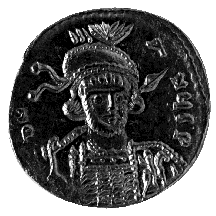



(137) Constantine IV - AV solidus, A.D. 674-681, 4.42 g. (inv.
91.277).
Obverse: Helmeted and cuirassed bust of Constantine IV three-quarter r.,
holding spear behind head in r.; shield with attacking horseman at l. shoulder;
D(OMINVS) N(OSTER) (CONST)AN(TIN)VS P(ERPETVVS AVGVSTVS): Our lord Constantine,
perpetual Augustus.
Reverse: Cross potent on stepped base, with Heraclius on l. and Tiberius
on r., each wearing chlamys, crown with cross, and holding globus
cruciger in r.; VICTORIA AVGV(STI) E: Victory of the Augustus, officina
mark E; in exergue, CONOB: gold of Constantinople.
Provenance: Hesperia Art, 1959.
Bibliography: W. Wroth, Catalogue of the Imperial Byzantine Coins in
the British Museum (London 1908) 3; P. Grierson, Byzantine Coins
(London 1982).
Constantine IV came to the throne after the murder of his father, Constans
II, in A.D. 668 and ruled first in association with his brothers, Heraclius
and Tiberius. In A.D. 681, however, after the birth of his son, Justinian,
Constantine deprived his brothers of their imperial titles and had their
noses cut off, an oriental custom indicating that they were no longer fit
for office. Afterwards he ruled alone until his death in A.D. 685. The most
significant event of the reign of Constantine IV was the Arab siege of Constantinople,
which lasted from A.D. 674 until A.D. 678 and ended with the decisive defeat
of the Arabs.
On this solidus, Constantine briefly revived the old armored portrait bust,
which had for the most part been replaced by the portrait of the emperor
wearing the chlamys (see no. 135). His use of the type in this period
may have been an attempt to recall the great military emperors such as Justinian
who had used the military type in the sixth century.
The reverse indicates that the coin dates from the period before the deposition
of Constantine's brothers. Here he continues the dynastic tradition of his
father's coins, which had depicted all three brothers, with the youngest
two, Heraclius and Tiberius, on the reverse. Heraclius is identified as
the elder by his height and position on the left. The legends of the coins
of Constantine IV, as this coin demonstrates, are often so crude and abbreviated
that they are illegible.
R.K.B.



All contents copyright (c) 1996.
Lawrence University
All rights reserved.